Blog Posts Tagged Heat Transfer Module
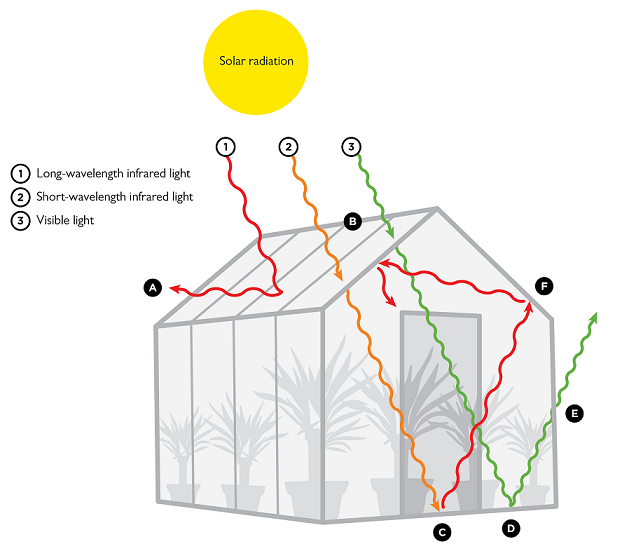
The Greenhouse Effect
Given the title of this blog post you might expect it to be about global warming, and I won’t blame you for it; greenhouse effect has become another popular term used when debating climate change. However, its original and literal meaning refers to a very different process, in particular when it comes to heat retention. Here we will describe the effect of heating up an actual greenhouse and suggest steps for optimizing its design.
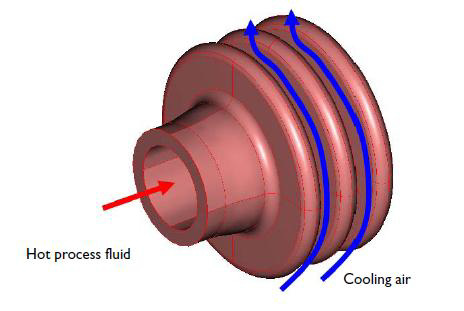
Cooling Flange Performance Analysis
Chemical reaction fluids can be cooled using glass flanges. The reaction fluid is passed through the flange and the air surrounding the flange then serves as the coolant. Engineers looking to optimize the cooling performance of such flanges can look to simulation for help.

The Graphene Revolution: Part 2
In a previous blog entry I discussed some of the exotic properties of graphene. The fact that graphene consists of a single layer of atoms means the aspect ratio of any graphene-based structure may be very high. High aspect geometries present their own array of modeling challenges.
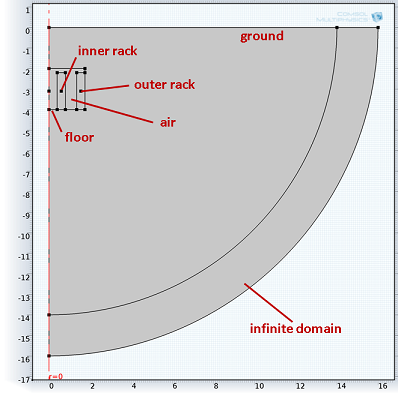
Modeling Temperature of a Wine Cellar
A lot of effort is put into inventing or improving existing technologies used to cool buildings, food, or any goods that need to be stored at a definite temperature. The reason is simple: adopting more efficient designs will result in achieving the same goal while consuming less energy. Both our balance sheet and the environment will benefit from these solutions. Here we will explore modeling temperature of a passive cooling design using a wine cellar as an example.
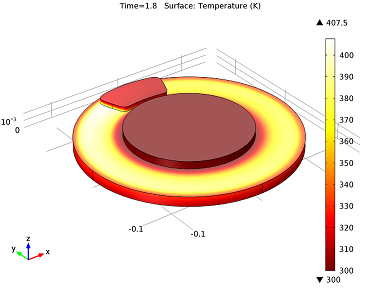
Simulating Heating of Brake Discs in a Car
Cars need brakes for obvious reasons, and you don’t want these to fail. Brake failure can be caused by many things, one of which is the overheating of the brake’s disc. As I’ve said before, no engineer wants to design a product that fails, which is also true in the case of brake-disc design. Let’s study a scenario of a car in panic brake mode, and find out how hot the brake discs and pads get as well as how […]
Long-time Multiphysics User on COMSOL for Heat Transfer
Having used COMSOL Multiphysics for over six years now, we are pleased to have Dr. Jon Ebert, Director at SC Solutions, join us in the next Mechanical Engineering Magazine Webinar Series titled “Heat Transfer in Solid and Fluids”. On March 7th, he will co-host an instructional webinar together with COMSOL’s John Dunec. Dr. Ebert will discuss SC Solution’s simulation activities within a wide span of heat transfer-related applications, particularly with respect to semiconductor manufacturing. As a long-time user of COMSOL […]

Upgrading the Nuts and Bolts of the Electrical Grid
The electrical grid describes the network created for producing electricity, transmitting it and delivering it to the consumers. A “smart grid” is an electrical grid that gathers information on the suppliers and consumers automatically to improve efficiency and sustainability in the system. As the automated technology improves, the hardware that physically connects the electrical grid together must improve as well. This hardware, the “nuts and bolts” of the grid, is comprised of transformers, cable joints, terminations, bushings, and fault current […]
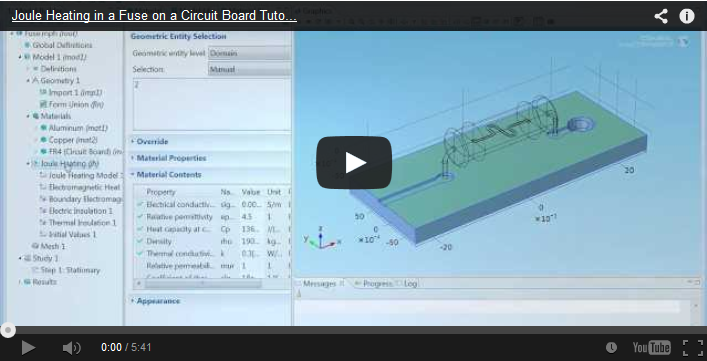
Joule Heating Simulations Tutorial
One of the classic multiphysics couplings in engineering and science is Joule heating, also called resistive heating or ohmic heating. Some Joule heating examples include heating of conductors in electronics, fuses, electric heaters, and power lines. When a structure is heated by electric currents, the device can reach high temperatures and either structurally degenerate or even melt. The design challenge is to remove this heat as effectively as possible. COMSOL eases these challenges by providing a specialized multiphysics interface for […]
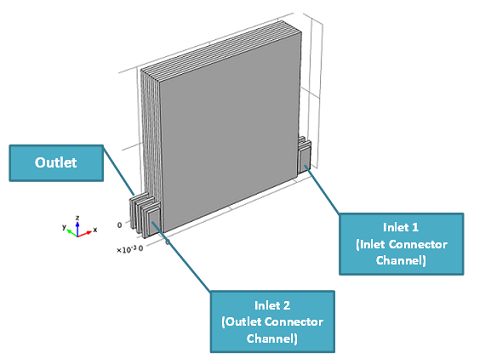
Modeling Lithium-Ion Battery Cooling
Get a brief introduction to creating a lithium-ion battery model using the COMSOL Multiphysics® software in three sequential studies. At the end of the blog post, there is a link to download the tutorial model.

The Science of Cooking, Multiphysics meets Food
It’s that time of year again for all the foodies out there; on January 29th the 2013 Bocuse d’Or will be in full swing with 24 chefs each representing their country, vying for the Gold Medal in the Olympic Games of the culinary world. In this biennial event, the chefs will have to combine classical and innovative cooking techniques to come out on top. At the last Bocuse d’Or in 2011, Gunnar Hvarnes propelled past the competition with the aid […]
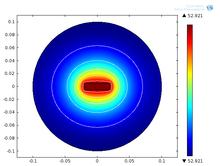
Gold Nanorods for Medical Treatment
Nanorods are synthetic nanoscale objects used in the area of nanotechnology. They can be synthesized from semiconducting materials or metals, such as gold. The applications of nanorods are many, ranging from display technologies and energy harvesting to cancer therapy.
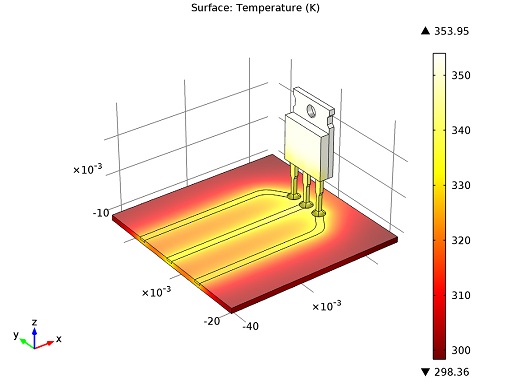
Power Transistors and Heat Transfer
Transistors are building blocks of electronic appliances, and can be found in radios, computers, and calculators, to name a few. When working with electrical systems you typically have to deal with heat transfer; electric heating is often an unwanted result of current conduction. Is a heat sink mounting necessary to keep the transistor cool, or can it manage without? Let’s have a look at power transistors from a heat transfer perspective.

Modeling a Burning Candle, How Would You Do It?
This holiday season most of us will have burned our fair share of candles. The flickering light of candles can really enhance the ambiance and put you in festive spirits. This reminds me of an analysis of a burning candle developed by AltaSim Technologies back in 2010. So, in tune with the holiday cheer, here are some candle physics.
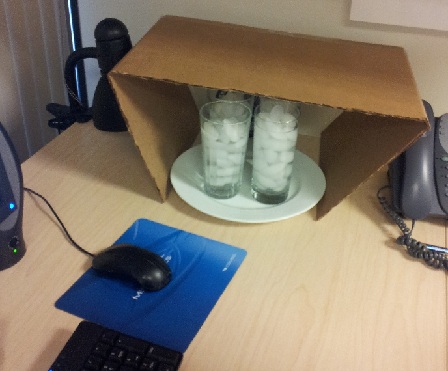
Make-shift Air Conditioner: How Engineers Can Stay Cool at Work (Maybe)
The winter here in Boston has been very mild so far. A few days I would even have liked to have the air conditioning back on. I checked in with one my colleagues to check if he was having an equally hard time staying cool, and to my surprise, he was not. Why? He had constructed a make-shift air conditioner (A/C).

Keynote Video: Multiphysics Simulation for Patient Safety
The second video in our COMSOL Conference Boston 2012 keynote series features Dr. Alan Leewood’s presentation on the use of multiphysics simulation for medical safety applications. The focus of this presentation is on the safety of passive conductive implants during MRI screenings.

First Keynote Video Takes Us to Babel
One of the differences between this year’s COMSOL Conference, and previous years’, is that this year we filmed a lot of it. During the next few weeks we will be publishing some of these videos for those that were there, to enjoy it once again, and for those that weren’t to get a taste of what went on. To kick these all off, I’m proud to present the first keynote video, which takes us to Babel.
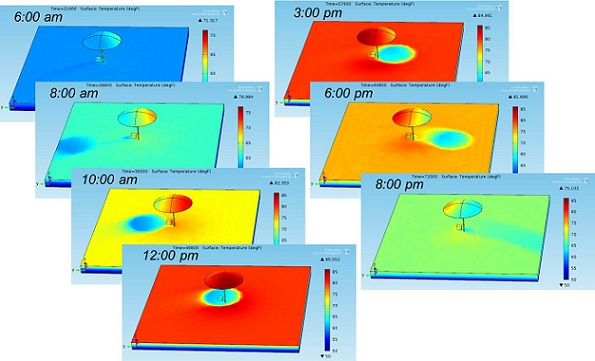
Solar Radiation: How Engineers Can Stay Cool on the Beach (Maybe)
The end of August marks the end of summer here in New England. Already nostalgic and unwilling to let the season go, I decided to look into some “beach physics”. In May we released a new solar radiation feature in our Heat Transfer Module that will be helpful in many solar applications — including how to avoid overheating on the beach, apparently. Here’s how engineers can stay cool on the beach.
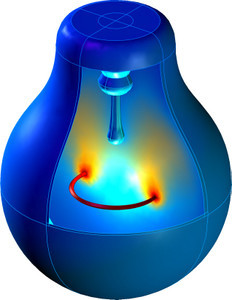
Modeling a Light Bulb, All Forms of Heat Transfer
When it gets dark, you flick on the lights. If you were to model this simple example, you would need to take all forms of heat transfer within consideration; convection, conduction, and radiation are all at play when a light bulb is flicked on.
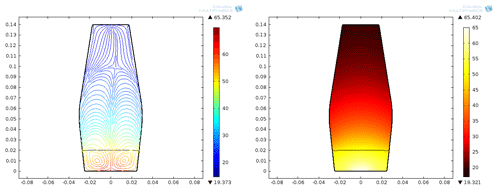
A Closer Look at the Physics Involved in Lava Lamps
Remember those retro desk ornaments of the 1960’s, those lamps filled with colorful wax that began to move when the lamp was lit? I’m talking about lava lamps, or as I like to call them, “Rayleigh–Taylor instability machines”. They may not be popular among today’s youth, but I still own one and I thought it would be interesting to look beyond the dyed blobs of wax and observe the physics involved in lava lamps.
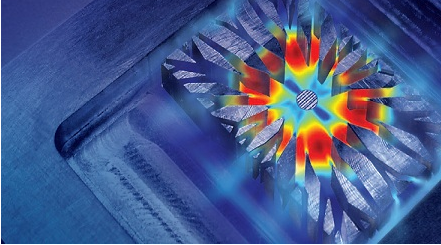
A Cooling Story for These Sweltering Days
I have just come back from a bit of a vacation and boy was it hot! Here, a large part of the US has been going through record high temperatures and most of my time was spent trying to keep cool. How nice then to mention a story about cooling.
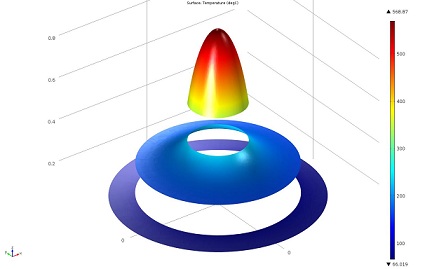
Space Fuel: Oak Ridge National Laboratory to Produce Plutonium-238
The end of July marks the beginning of a $20 million R&D project led by the Oak Ridge National Laboratory (ORNL) to produce and process plutonium-238. The U.S. space program will be using the Pu-238 that is to be produced by ORNL as fuel for future deep-space missions.

Inventing Makes use of Simulation
One of the interesting stories to come out of the latest COMSOL News concerned a couple of great researchers, Dr. Ozgur Yildirim and Dr. Zihong Guo, and how they use simulations in their inventing process. They work in an invention/prototype laboratory in Bellevue, WA for Intellectual Ventures, a global leader in the business of invention.
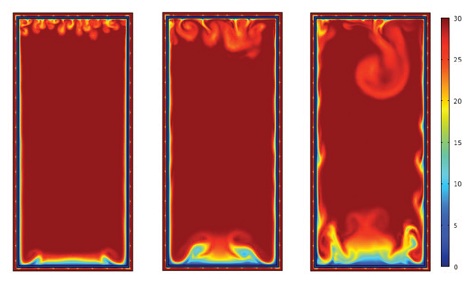
A Cool Way to Consider the Environment
According to a study done by Brunel University in the United Kingdom, the food sector is among the top five energy-consuming industries. The transportation of food, including keeping it refrigerated, is one of the larger contributing factors to this energy-consumption and subsequent greenhouse gas emissions.
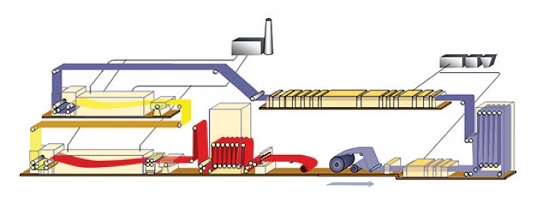
Giving the Power of COMSOL to the Operator
COMSOL News is now available in print and electronically, and you can request your copy of the multiphysics simulation magazine here. One of the great stories concerns a process engineer at Ruukki Metals in Finland, Mika Judin, who not only uses COMSOL to model and optimize his process, but lets the operators use the simulation too.
